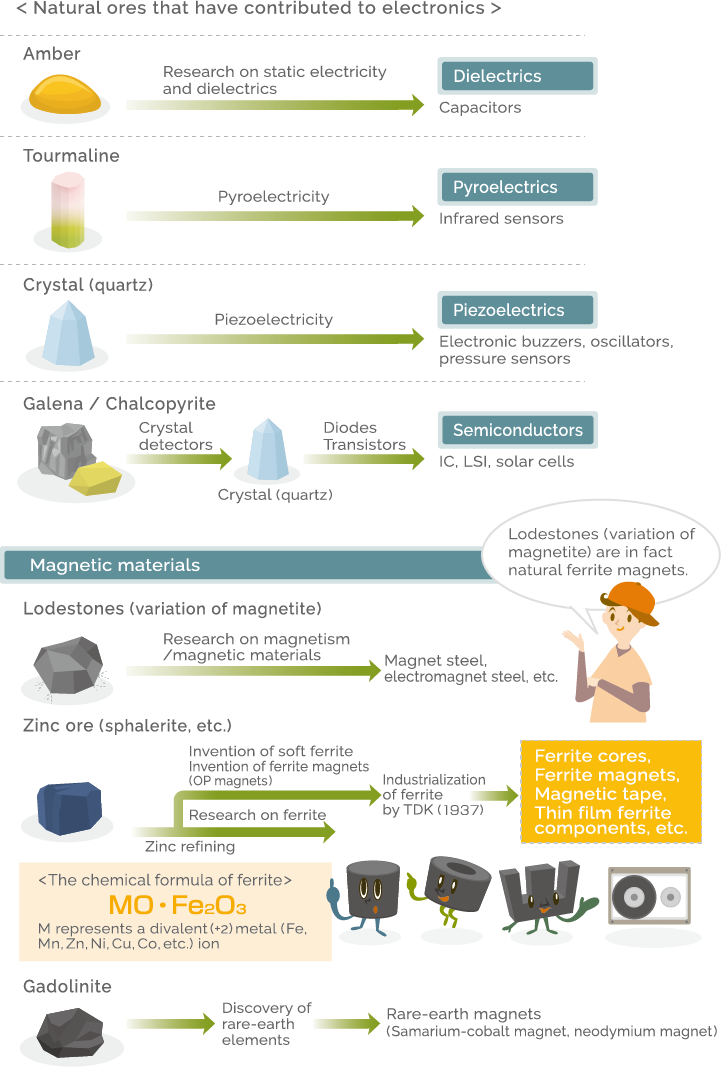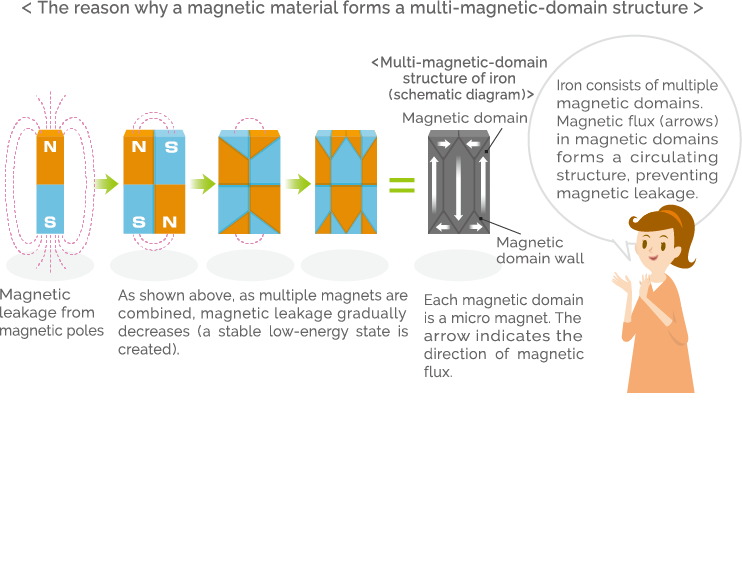Ferrite World
Vol. 2 Ferrite cores necessary for energy-saving power supply

Magnetic hardness/softness is associated with the microstructure of the material
As described in the previous installment of this series, magnetic materials are roughly classified by their properties into hard magnetic material and soft magnetic material; the former becomes a permanent magnet when external magnetic fields are applied to it, and the latter becomes a temporarily magnet due to external magnetic fields. Interestingly, magnetic hardness and softness correspond to physical hardness and softness when it comes to iron. For example, when steel for blades, tools, etc. is rubbed with a magnet, it is magnetized and itself becomes a magnet. Steel shows hard magnetism as described above, but when annealed (heated to red-hot and then cooled slowly), it becomes a nearly soft magnet while losing hardness and becoming dull. This is due to changes in metallographic structure (steel phase).
An annealed blade regains hardness with its metallographic structure changed, when reheated to red-hot and cooled quickly with water. This process, which is well-known for Japanese sword making, is called “Quenching.” KS steel, which was invented by Dr. Kotaro Honda in 1917 as magnet steel that was much stronger than conventional materials, is a magnet material with magnetic properties improved greatly by this quenching process.
Magnetic materials are divided into metal materials and oxide materials. A typical oxide magnetic material is ferrite. Like iron and steel, ferrite also depends on what the microstructure is like, in terms of magnetic hardness and softness. However, ferrite is decidedly different from metal magnetic materials such as iron and steel in that it has a considerably extremely high electrical resistance.
Ferrite is a magnetic ceramic manufactured by mixing, molding, and sintering powdery raw material made up by mixing iron oxide, which is the main raw material of ferrite, with other metal oxides and a small amount of additive. Through the sintering process, the raw material forms a solid solution, and becomes a polycrystal in which fine crystal grains gather. The boundaries between crystal grains are called grain boundaries. Ferrite, which is a polycrystal, shows high electrical resistance equivalent to that of insulators, thanks to these three-dimensional netlike high-resistance grain boundaries. Also, most of the small amount of additive gathers at these grain boundaries (segregation). Therefore, grain boundaries take a key role in the properties of ferrite.
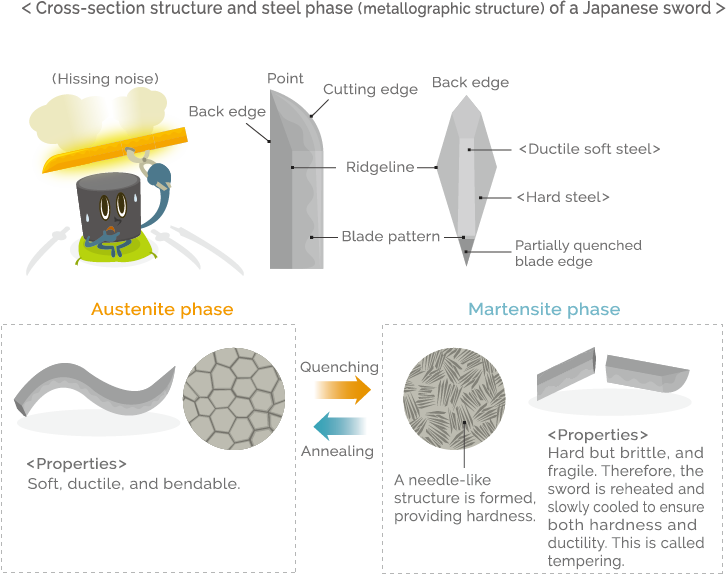
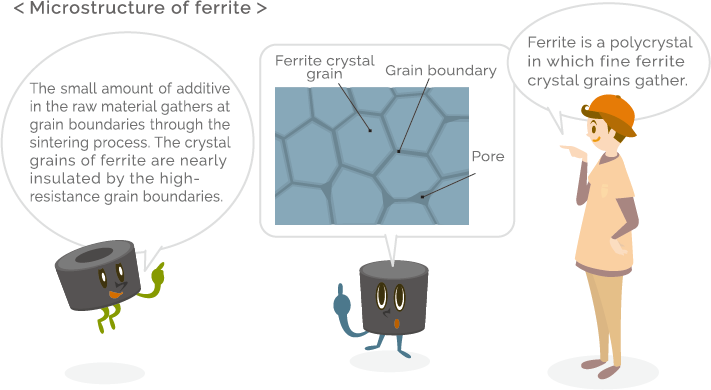
A transformer is an alternating voltage converter using electromagnetic induction
Magnetic materials absorb magnetic flux in a similar way that sponges absorb water. Such absorbability is called magnetic permeability, and capacity to absorb magnetic flux is called saturation magnetic flux density. A feature of metal materials typified by iron is that they have a high saturation magnetic flux density. Meanwhile, ferrite (generally it means soft ferrite when simply referred to as ferrite) is an oxide magnetic material represented by the chemical formula MFe2O4 (M represents a divalent metal). It has oxygen atoms, which are not magnetic atoms (e.g., Fe), so it cannot surpass metal materials in terms of saturation magnetic flux density. For example, an electromagnet core (magnetic core) becomes stronger if it has a higher saturation magnetic flux density. Therefore, soft iron (soft magnetic iron) or the like is used as an electromagnet core.
While direct current is passed through the coil of an electromagnet, alternating current is passed through the coil of a transformer. The role of a transformer is to convert alternating voltage, and its principle is electromagnetic induction, which was discovered by Michael Faraday in 1831. When a magnet is quickly pushed into and pulled out of a coil, an electromotive force (voltage) is generated in the coil, causing current to flow. This can be easily confirmed by an experiment, but during Faraday’s time, there were no strong magnets or high-sensitivity galvanometers, so it seems that he had a lot of trouble.
The experimental equipment for the discovery of electromagnetic induction was a donut-shaped soft iron wound with two wire coils (this is called a Faraday ring). Faraday found that when one coil was repeatedly connected to and disconnected from a battery (voltaic pile), current flowed through the other coil. At the moment when the current was turned on/off, a sudden magnetic flux change occurred in a coil. Such a flux change generated an electromotive force in the other coil through the soft iron core. This is the same as the principle of a transformer. Alternating current (AC) is a current that changes the direction at a determined frequency, and each time it changes the direction, a sudden magnetic flux change occurs and magnetic induction generates electromotive force in the secondary coil. The magnitude of electromotive force is determined by the ratio of the number of turns in the two coils, and, therefore, this principle applies to a transformer to convert alternating voltage.
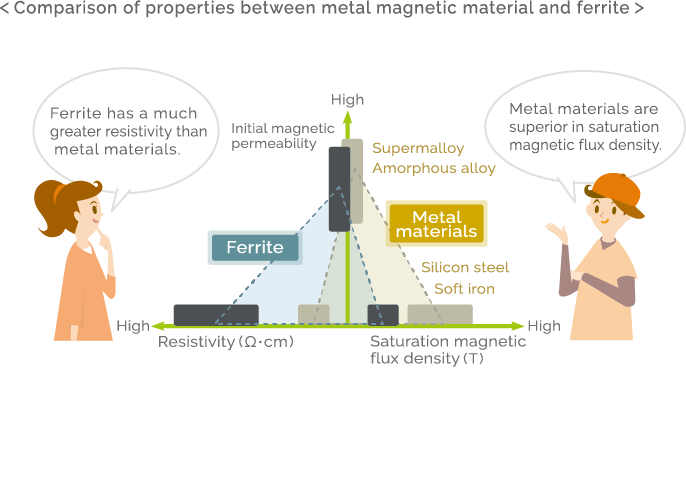
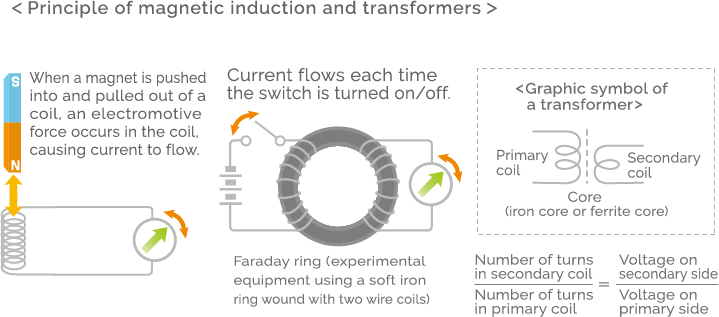
Power ferrite utilized in small high-efficiency switching power supply
AC adapters are devices to convert commercial alternating current to direct current and to supply it to electronic devices. There are various types of AC. As a conventional type, stocky-shaped AC adapters are used for cordless phones, electrical tools, etc. You must find them heavy in your hands, mostly because of the iron core of the power transformer. Such an iron core is not a block core like an electromagnet core but is a core layered with thin plates of soft magnetic metal such as silicon steel (laminated iron core).
There is a deep reason why a laminated iron core is used. When a magnetic flux change occurs in the core, reaction magnetic flux occurs in a direction to prevent the change. This is similar to the reaction force that occurs when an object is pressed. The occurrence of magnetic flux reaction means the occurrence of current flow in the electrical conductor. This is called eddy current. When eddy current flows, Joule heat is generated due to the electrical resistance of the core, and this leads to the problem of energy loss (heat loss called iron loss). This is because this heat quantity is proportional to the square of the flowing current. Since metal cores have low electrical resistance, they allow large current to flow, increasing heat generation. The use of a laminated iron core is a device to reduce heat loss. Its thin plates are electrically insulated, so eddy current occurs in each thin plate. This causes the routes of eddy current to lengthen, increasing a resistance value and reducing the amount of heat generation.
However, this heat loss is proportional to the square of the frequency. Even though a laminated iron core can be used at the frequency of commercial alternating current (50/60 Hz), it generates a large amount of heat and finally becomes red-hot in a kilohertz, megahertz, or higher-frequency range. Thus, ferrite is needed. This is because, since ferrite has more than 100,000 times as many resistance values as metal materials and it causes less heat loss even when used at high frequencies.
Small and lightweight AC adapters are used for mobile phones and laptop computers. They are called switching AC adapters. They use a ferrite core transformer to convert high-frequency pulse current to the required voltage. Switching power supplies feature a very small size and a significantly high efficiency as compared with conventional power supplies. These switching power supplies are used for most electronic devices using commercial alternating current such as TVs, DVD recorders, and gaming consoles. Ferrite used for applications such as power supplies is especially called power ferrite. TDK develops lower-loss power ferrite materials by utilizing the technologies and knowhow we have accumulated over many years, and this is how we significantly contribute to energy-saving in the entire society.
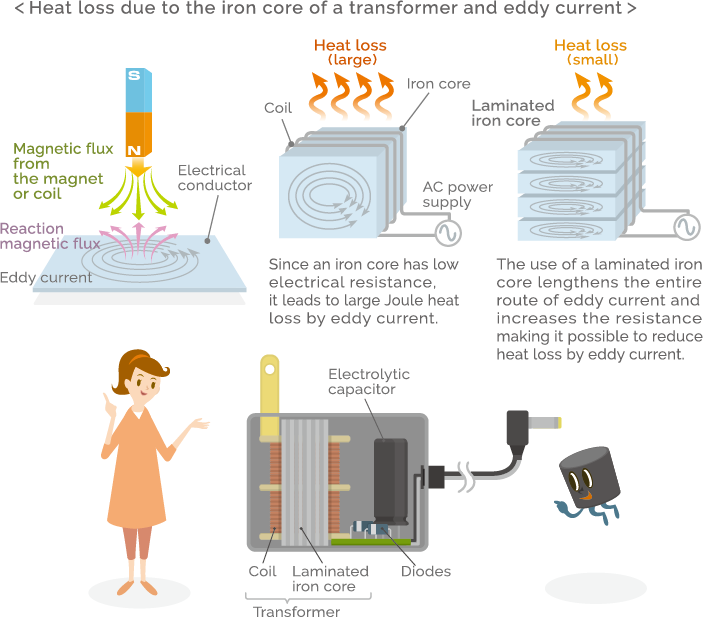
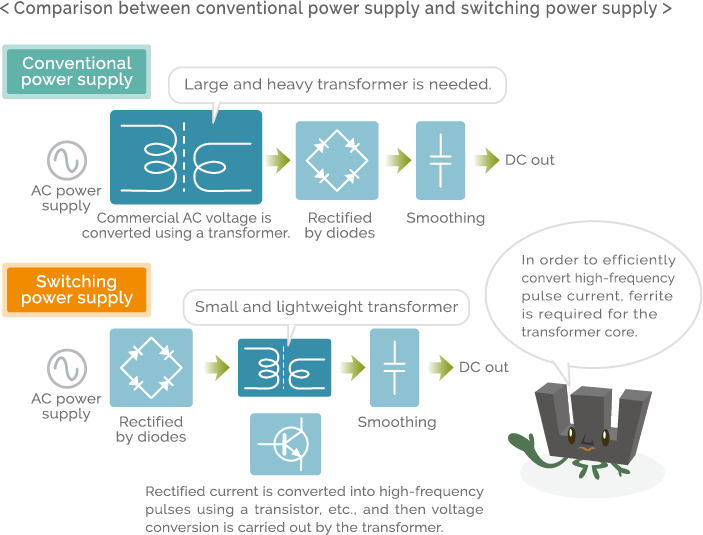
TDK is a comprehensive electronic components manufacturer leading the world in magnetic technology



